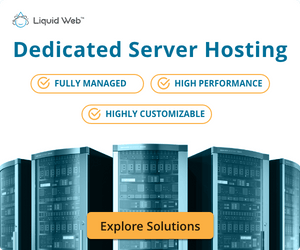Moving to a Multi-Dedicated Setup
In today’s hypercompetitive business climate, your online presence must meet your customers' needs. If your business needs are not extensive, a wide range of hosting options are available. But what if you have different, more specific needs? What if basic web hosting is not enough for your business, employees, and customers?
In some cases, the cloud is a good solution. In other cases, a single dedicated server is sufficient to get the job done. But for websites and applications that require more resources and customization, a multi-dedicated setup is the right choice.
This post examines multi-dedicated setups and the best use cases for them. You will learn details on migrating your website to a multi-dedicated server setup, pitfalls to avoid, and optimization tips. Ultimately, you will understand the best way to leverage a multi-dedicated server setup for your organization.
What Is a Multi-Dedicated Server Setup?
A multi-dedicated server setup is a hosting environment with more than one dedicated server networked to improve uptime and performance for hosting applications or storing data. An example of a multi-dedicated server setup would be an e-commerce website with variable traffic loads that must be prepared for a spike with little advanced notice.
By having more than one dedicated server working in concert, the site would have more stable uptime and high performance compared to using a single dedicated server or VPS. This type of hosting environment gives businesses more power and flexibility than other hosting configurations. This allows businesses to customize their server environment to meet their specific needs.
The traditional hosting path for many websites and applications starts with a simple environment like a shared hosting plan. As site traffic grows or as more users flock to an application, hosting needs change.
First, the site will likely upgrade to a larger shared plan with more resources before graduating to a virtual private server (VPS). Once a VPS is no longer sufficient, more needed resources will ultimately drive the site to a dedicated server or cloud environment. At this size and scale, needs often become more complex than simply adding more RAM or storage. That’s where a multi-dedicated server setup comes in. With a multi-dedicated server configuration, an application or site will be far less constrained when adding additional resources.
Furthermore, a multi-dedicated server setup brings with it several customizable components that are not available with other server configurations. For example, you'll get your own IP address, control panel, and operating system. You'll also be able to customize your server environment to meet the specific needs of your business.
A multi-dedicated setup can ensure that your website will have the resources it needs to run smoothly and efficiently.
Should Your Business Use a Multi-dedicated Server Setup?
There is no one-size-fits-all answer to this question. Whether or not to use a multi-dedicated server setup depends on various factors, including the size of your business, budget, and technical expertise.
Your resource needs will factor into deciding whether to use a multi-dedicated server setup. If you need extra storage or compute power, or if you experience variable traffic patterns and loads, a multi-dedicated server environment is certainly worth considering.
You may benefit from using a multi-dedicated server setup if you're running a medium or large business. This is especially true if you have the budget to invest in a high-quality server. A multi-dedicated server setup will give you more control over your website and applications and allow you to customize your server environment to better meet your business's needs.
Benefits and Drawbacks of a Multi-Dedicated Server Setup
The main advantage of a multi-dedicated setup is that it provides power and flexibility without losing control. For example, while the public cloud can provide equal (or even superior) scalability, it's not great for storing certain kinds of data or running certain types of applications. At the same time, there are some drawbacks and disadvantages when it comes to a multi-dedicated server setup.
Benefits of a Multi-Dedicated Server Setup
There are many benefits to using a multi-dedicated server setup for your business. Some of these benefits include the following:
- More power and flexibility: With a multi-dedicated server setup, businesses have more control over their server environment. This means businesses can customize their servers to meet their specific needs.
- Increased uptime: When you have your own server, you're not sharing resources with other businesses. This can lead to increased uptime for your website.
- Better performance: With a multi-dedicated server setup, businesses can ensure that their website has the resources it needs to run smoothly and efficiently.
- Increased security: When you have your own server, you're not sharing resources with other businesses. This means that your website will be more secure from attacks.
Drawbacks of a Multi-Dedicated Server Setup
There are some disadvantages to using a multi-dedicated server setup for your business. Some of these disadvantages include the following:
- Higher cost: Multi-dedicated setups are more expensive than shared hosting plans. This is because businesses are paying for their own server (or servers).
- Requires technical knowledge: Setting up and maintaining a multi-dedicated server calls for specific technical knowledge. Therefore, it's essential to make sure that you have someone on staff with the necessary skill set.
- Can be difficult to scale: As your business grows, you may need to add more servers to your setup. This can be challenging if you're not familiar with the technical aspects of a multi-dedicated server setup.

Use Cases for a Multi-Dedicated Server Setup
There are many businesses that can benefit from using a multi-dedicated server setup. Some of the businesses that may benefit include:
E-Commerce Businesses
E-commerce businesses need a fast and reliable website. A multi-dedicated server setup can give them the power and flexibility they need to run their website smoothly.
Businesses With High Traffic or Surges in Traffic
If your website gets a lot of traffic, you may need a dedicated server to handle the load. A multi-dedicated server setup can be a great option for businesses with high traffic spikes from flash sale models or social media-driven traffic.
Businesses With Custom Applications
If you have custom applications or software that you need to run on your website, a multi-dedicated server setup can give you the flexibility to run them smoothly. Multi-dedicated environments provide the memory and performance necessary to handle the load from the most resource-intensive applications.
Businesses With Sensitive Data
If you're handling sensitive information like medical data for HIPAA compliance, a multi-dedicated server setup can give you the security and peace of mind you need.
How To Migrate Your Website to a New Multi-Dedicated Server Setup
If you're ready to migrate your website to a new multi-dedicated server setup, there are a few things you need to do.
- Determine the right hosting provider for you: When you're choosing a hosting provider, it's important to confirm that they offer a multi-dedicated server setup. Not all hosting providers offer this type of setup, so be sure to do your research.
- Choose the right server: Once you've found a hosting provider that offers a multi-dedicated server setup, you need to choose the right server for your business. See that you consider your business's needs when choosing a server.
- Migrate your website: Once you've chosen your new server, you need to migrate your website to it. Take care to back up your website before you begin the migration process.
- Rigorously test your website/application: Migrating to a multi-dedicated environment for the first time is challenging for even seasoned IT veterans. Don’t rush it. Be sure to include extended testing phases with dry runs to confirm the functionality of your website or application before scheduling your final live migration.
- Go live: Once you've tested your website and everything is working properly, you're ready to go live with your new multi-dedicated server setup!
3 Common Problems With Migrating to a New Multi-Dedicated Server Setup and How To Solve Them
If you're planning to migrate your website to a new multi-dedicated server setup, there are a few things you need to watch out for. Here are three common problems you may encounter:
- Not enough resources: Having the resources necessary for your website to handle its traffic and run its applications is a must. Make certain that choose a server with sufficient bandwidth, disk space, memory, and processing power to support your website’s needs.
- Incompatibility: Your operating system, applications, database, scripts, and plugins must all be compatible with the new server in order to function properly. Be sure to check compatibility before you migrate your website.
- Downtime: Before you begin your migration, it’s critical that you consider the effect downtime will have on your website. You may lose visitors or even customers if your site is down for too long. Rigorous testing prior to scheduling your final migration is a necessity for properly executing your migration with minimal downtime. Migrating during non-peak or off-hours when you'll have the least amount of site traffic is ideal.
5 Tips for Optimizing Your Website for Performance on a Multi-Dedicated Server Setup
- Use a content delivery network (CDN): A CDN delivers content from a server that is closer to the visitor's location, which can help improve your website's performance.
- Cache your data: Caching can help improve your website's performance by storing frequently accessed data in memory so it can be quickly obtained by visitors.
- Adopt a load balancer: A load balancer can help improve your website's performance by distributing traffic evenly across all of the servers in your multi-dedicated setup.
- Use multiple server locations: Using multiple server locations can help improve your website's performance by providing visitors with a server that is closer to their location.
- Employ solid state drives (SSDs): SSDs can help improve your website's performance by providing faster access to data.
Is a Multi-Dedicated Environment Right for You?
A multi-dedicated setup can benefit both your website and your business. You can get the best of both worlds by gaining the power of dedicated server hosting while keeping some of the shared hosting features you know and love. Multi-dedicated environments are a great idea for businesses in the e-commerce space or those with complex applications and websites.
The team at Liquid Web specializes in complex infrastructure environments. They can help design, deploy, and maintain your multi-server setup so you can get the most out of your online presence. For over 25 years, the Most Helpful Humans in Hosting have been helping small and mid-sized businesses reach new heights. To learn more about how Liquid Web can help your business with a multi-dedicated hosting environment, contact them today.

Jason Potter
A veteran of the IT Support field, I have more than a decade of experience in systems administration, web hosting, and cPanel servers. I enjoy writing and providing complicated technical concepts in layman terms. On my free time, I enjoy playing several types video games, automation scripting and just living life with my wife and two kids.
Keep up to date with the latest Hosting news.



